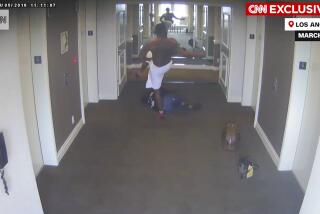Death Row Inmate Was Calm, Alone to End
In the hours before his 1993 execution, quadruple killer David Edwin Mason wanted to talk football. Manuel Babbitt, rapist and murderer, decided to read his mail before walking to the death chamber in 1999.
Inmates executed at San Quentin State Prison portray a certain stoicism as the end grows near. But in their final hours, said Capt. K.J. Williams, who oversees the 594 men housed on death row, they betray their true feelings, rambling incoherently and choosing subject matter--such as the talent of former NFL quarterback John Elway--that seems desperately removed from the matter at hand.
Not Stephen Wayne Anderson.
In his final days, corrections officials and prison guards said Monday and Tuesday, Anderson was disarmingly calm. He refused to go outside. He had given his few possessions to fellow inmates at San Quentin State Prison. Five days ago, he told guards to stop sending spiritual advisors to chat. Then he stopped accepting visitors altogether. He stopped taking phone calls, too.
And then, in the end, the loneliest life ended in the loneliest way.
“Twenty years in here, I think it caught up with him,” said Williams. “This was a part of his destiny. He accepted it.”
A drifter who shot and killed an 81-year-old grandmother in 1980 while trying to burglarize her San Bernardino County home, Anderson became early Tuesday the 10th man executed in California since voters reinstated the death penalty in 1978. He was 48.
Almost all of them, taking advantage of relaxed restrictions on visitation in their final days, were surrounded by friends, relatives and counselors. But Anderson--resigned to his fate, sleeping soundly and maintaining a robust appetite that kept him close to 300 pounds--was more alone at the end than any inmate prison officials could remember. He had two sons, but he barely knew them--one, in his late 20s, still doesn’t know his father was executed--and they did not visit. No friends visited.
“Periodically, he was asked if he wanted anything or anyone,” said California Department of Corrections spokesman Bob Martinez. “The answer was: ‘Negative.’”
He had grown close to his attorneys, but in the end lost interest in their campaign to get his sentence commuted to life in prison. He felt seeing them would be a waste of their time and his, Williams said before Tuesday’s execution.
“He just completely withdrew,” Williams said. “They all play tough. But after a while, you can tell it’s getting to them. Not this guy. This was an unusual man. These people have done some terrible things, but they are still people. In a sense, this is the last dignity they have--to die with dignity. And he will do that.”
Anderson was expressionless as he entered the chamber at 12:05 a.m. and was helped onto the gurney. He did not resist or speak as guards strapped down his ankles, then removed heavy chains that bound his arms to his waist.
The guards unclenched his fists and taped down his fingers. Setting a box of new syringes on his legs, as if he were a workbench, they hooked intravenous lines to his tattooed arms, then left and locked the door behind them. He was alone, blinking at the ceiling of the 7-foot-wide, hospital green capsule.
A prison guard took a rolled-up script passed to him through a death chamber keyhole and announced in a jarring voice, in case there was any confusion: “The execution shall now proceed.”
Anderson strained his head several times to look toward the 40 witnesses. One of his attorneys, Margo Rocconi, mouthed the words “I love you” to him several times. His eyes blinking, his right foot twitching, he mouthed the words “thank you.”
His breathing became strained and heavy, his chest heaving every five or six seconds. The blood drained from his face, his head rolled to the right and he was motionless by 12:23 a.m. After seven minutes, during which the only sound was the clunking of boiler pipes and the periodic beeps of medical equipment, he was pronounced dead.
Though Anderson had been allowed to designate seven witnesses, he chose just three, all believed to be members of his defense team. Relatives of his victim had made it clear that they did not want him to die for his crimes, and they declined to witness the execution. Inside were attorneys, law enforcement officers and journalists.
There were no tears--there was little emotion at all, which only seemed to bolster the defense’s contention that no one cared whether Anderson died besides San Bernardino County prosecutors. Prosecutors say that when it came to Anderson, their “client” was the public because murder is a crime against society.
Anderson told prison officials he did not want to make a final statement, saying his vast collection of prison poetry and essays would speak for itself. Prosecutors could not be reached for comment Tuesday. Anderson’s seven-member defense team issued a statement Tuesday morning saying, in part:
“Mr. Anderson was ... executed despite the fact that his life had redeeming value and that, as the poet laureate of the condemned, he still had so much more to contribute to the world. It has been a privilege to represent him. We will miss him greatly.”
Williams and other officials said Anderson was a loner to the end.
“Those,” Williams said, shaking his head toward the cellblocks, “were his only friends.”
But even they seemed to want it over with--because they don’t think much of murderers either. On Monday, inmate Rich Geddis, an Oakland dockworker who recently violated his probation when he got in a verbal altercation with his parole officer, was asked to sweep the prison steps. Though San Quentin is known for death row, the majority of its 6,000 inmates--like Geddis, originally imprisoned for grand theft--are not killers.
The prison is locked down on execution days, which alters the routine of other inmates, prohibiting them, for example, from going to the exercise yard.
“The system makes it look like we care. It makes us look like we support these people, like we are going to stand behind them,” Geddis said. “But we consider them a different class of people. Most of us are normal people, with families and everything. Most of them have done some pretty awful things. They are on death row for a reason. I think they should do it.”
Times staff writer John M. Glionna and correspondent Daniel Hernandez contributed to this report.
More to Read
Sign up for Essential California
The most important California stories and recommendations in your inbox every morning.
You may occasionally receive promotional content from the Los Angeles Times.











